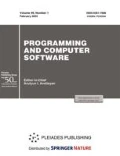Abstract
A representation of algorithms extracted from binary code by reverse engineering is discussed. Both intermediate representations designed for automatic analysis and final representations passed to the end user are considered. The two main tasks of reverse engineering—automatic detection of exploitable vulnerabilities and discovery of undocumented features— are analyzed. The basic scheme of the system implementing the automatic detection of exploitable vulnerabilities is presented and the key properties of the intermediate representation designed for solving this problem using an efficient generation of a system of equations for an SMT solver are described. The workflow for discovering undocumented features is described. These steps are the localization of the algorithm, its representation in the form that is convenient for analysis, and investigation of its properties. To automate the first phase, a combined static and dynamic representation is constructed, which includes OS-level events and calls to library functions; they serve as anchor points used by the analyst for the algorithm localization. The further support of localization uses code slicing and navigation algorithms. Once the algorithm is localized, the further work goes in two directions: interactive construction of a compact annotated representation of the algorithm by a flowchart and automated investigation of the algorithm properties aimed at determining declared and undeclared data flows. The representation of the algorithm is based on the construction of simplified models of functions taking into account input and output buffers and on the automatic detection of data dependences between buffers of various function calls. The overall scenario of the analyst' work with such a flowchart in the context of discovering undocumented features is described; this scenario is based on annotating the declared data flows and on the automatic detection of undeclared data flows. In conclusion, an example of the resulting representation is discussed and the directions of further research are discussed.
Similar content being viewed by others
References
Wang, X., Zeldovich, N., Kaashoek, M.F., and Solar-Lezama, A., A Differntial Approach to Undefined Behavior Detection, ACM Trans. Comput. Syst., 2015, vol. 33, no. 1, pp. 1–29.
Song, D., Brumley, D., Yin, H., et al., BitBlaze: A new approach to computer security via binary analysis, Inf. Syst. Security, 2008, pp. 1–25
Brumley, D., Jager, I., Avgerinos, T., et al., BAP: A binary analysis platform, in Int. Conf. on Computer Aided Verification, 2011, pp. 463–469
Shoshitaishvili, Y., Wang, R., Salls, C., et al., Sok: (state of) the art of war: Offensive techniques in binary analysis, in IEEE Symposium on Security and Privacy (SP), 2016, pp. 138–157
Cha, S. K., Avgerinos, T., Rebert, A., et al., Unleashing mayhem on binary code, in IEEE Symposium on Security and Privacy (SP), 2012, pp. 380–394
Defense Advanced Research Projects Agency Program Information: Cyber Grand Challenge (CGC). https://doi.org/www.darpa.mil/program/cyber-grand-challenge
Padaryan, V.A., Get’man, A.I., Solov’ev, M.A., Bakulin, M.G., Borzilov, A.I., Kaushan, V.V., Ledovskykh, I.N., Markin, Yu.V., and Panasenko, S.S., Methods and software tools supporting the combined analysis of binary code, Trudy ISP RAN, 2014, vol. 26, no. 1, pp. 251–276.
Ivannikov, V.P., Belevantsev, A.A., Borodin, A.E., Ignatiev, V.N., Zhurikhin, D.M., and Avetisyan, A.I., Static analyzer Svace for finding defects in a source program code, Program. Comput. Software, 2014, vol. 40, no. 5, pp. 265–275.
Koshelev, V.K., Ignat’ev, V.N., Borzilov, A.I., and Belevantsev, A.A., SharpChecker static analysis tool for C, Program. Comput. Software, 2017, vol. 43, no. 4, pp. 268–276.
Dudina, I.A. and Belevantsev, A.A., Using static symbolic execution to detect buffer overflows, Program. Comput. Software, 2017, vol. 43, no. 5, pp. 277–288.
Belevantsev, A.A., Multilevel static analysis for improving program quality, Program. Comput. Software, 2017, vol. 43, no. 6, pp. 321–336.
Kaushan, V.V., Mamontov, A.Yu., Padaryan, V.A., and Fedotov, A.N., A method for detecting some types of memory bugs in binary code, Trudy ISP RAN, 2015, vol. 27, no. 2, pp. 105–126.
Nethercote, N. and Seward, J., Valgrind: A framework for heavyweight dynamic binary instrumentation, ACM SIGPLAN Notices, 2007, vol. 42, no. 6, pp. 89–100.
Luk, C.K., Cohn, R., Muth, R., et al., Pin: Building customized program analysis tools with dynamic instrumentation, ACM SIGPLAN Notices, 2005, vol. 40, no. 6, pp. 190–200.
Bellard, F., QEMU, a fast and portable dynamic translator, in USENIX Annual Technical Conference, FREENIX Track, 2005, pp. 41–46
De Moura, L. and Bjorner, N., Z3: An efficient SMT solver, in Tools and Algorithms for the Construction and Analysis of Systems, 2008, pp. 337–340
Padaryan, V.A., Solov’ev, M.A., and Kononov, A.I., Simulation of operational semantics of machine instructions, Program. Comput. Software, 2011, vol. 37, no. 3, pp. 161–170.
Dullien, T. and Porst, S., REIL: A platform-independent intermediate representation of disassembled code for static code analysis, in Proc. of CanSecWest, 2009.
Fedotov, A.N., Padaryan, V.A., Kaushan, V.V., Kurmangaleev, Sh.F., Vishnyakov, A.V., and Nurmukhametov, A.R., Assesing the criticality of software vulnerabilities under the conditions of modern protection mechanisms, Trudy ISP RAN, 2016, vol. 28, no. 5, pp. 73–92.
Caselden, D., Bazhanyuk, A., Payer, M., McCamant, S., and Song, D., HI-CFG: Construction by binary analysis and application to attack polymorphism, in Computer Security–ESORICS 2013, Lect. Notes Comput. Sci., 2013, vol. 8134. pp. 164–181.
Author information
Authors and Affiliations
Corresponding author
Additional information
Original Russian Text © V.A. Padaryan, I.N. Ledovskikh, 2018, published in Trudy Instituta Sistemnogo Programmirovaniya, 2017, Vol. 29, No. 3.
The work was supported by RFBR grant 16-29-09632
Rights and permissions
About this article
Cite this article
Padaryan, V.A., Ledovskikh, I.N. On the Representation of Results of Binary Code Reverse Engineering. Program Comput Soft 44, 200–206 (2018). https://doi.org/10.1134/S0361768818030064
Received:
Published:
Issue Date:
DOI: https://doi.org/10.1134/S0361768818030064




